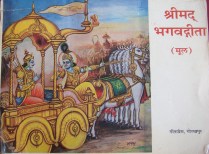This is a third post of a series of posts.

I keep the “congratulations to 2014 graduates” as a part of the post because I decided to write these four posts for the graduates. Of course, others can also enjoy reading and practicing these ideas.
I shared my thoughts on Jnana Yoga and Karma Yoga in the first part and Raja Yoga in the second part of this series.
In this post, I am going to share my thoughts on Bhakti Yoga. Bhakti Yoga is a path to attain the highest Knowledge or State or God-realization through love.
One can read more about Bhakti Yoga from the following books.




Why Bhakti Yoga?
Some people can reason well and can realize that “I am the divine soul and not body and mind.” They can align their thoughts, speech, and action to this conviction. These are Jnana Yogis.
Some people can easily become unselfish in one’s thoughts, speech, and actions, and live life serving all without any worldly motive. These are Karma Yogis.
Some people can control their senses and minds easily and can focus their minds on the inner divinity. These are Raja Yogis.
But there are many people who have difficulties in reasoning, becoming unselfish, and controlling the senses and the mind, and focusing the mind on an object of meditation. Such activities are not natural to them. What is the way for these people? The ancient teachers found that it is natural for most people to love. Most of us have experienced love between parents and children, teachers and students, between friends, and between spouses. The ancient teachers found that for most people it is easier to attain the highest knowledge through loving God. The Bhagavad Gita says that as long as we have body-consciousness, it is extremely difficult to think of God as formless (12.5). Thus this love of God comes in the relationship with a form of God . Swami Vivekananda says that if a fish thinks of God, it will think of a huge mighty fish. Similarly, when a human being thinks of God, he/she thinks of a super-human being.
How to develop love for a form of God?
Many people have this question: How can one believe an imaginary form as God and love this God? It is a genuine question.
For an answer to this question, we can look at this from different points of view. When we read a novel or watch a movie, we know very well that the hero and heroine are imaginary. But, we get attached to them. We think they are real and we become happy and sad with them. For sincere readers, these characters are real to them. Similarly, Sri Rama and Mother Sita from Ramayana and Shri Krishna from Mahabharata are real to many people. Not only that these forms are real to them, but by following the virtues of Sri Rama and Sita as exhibited by them in the Ramayana, and the teachings of Shri Krishna described in Srimad Bhagavad Gita and Srimad Bhagavatam, people can improve their lives and become good citizens in the society. This is exactly the reason why the Shiva Purana, Vishnu Purana, Devi Puarana and other Puranas were written. In each Purana, life incidents of a form of God or Goddess have been described. Devotees read them, get attached to them, follow their teachings, and improve their lives spiritually. If we look deeper, we find that the Ramayana, Mahabharata, and other Puranas have built up the Hindu culture. The Upanishads and Brahma Sutras provide the essential philosophy of life, but the great epics and the Puranas showed people how to put the essential teachings of the Upanishads and the Brahma Sutras into practical life.
In a way, everything is an imagination. A picture of our friend or relative in our mind is also imaginary. Yes, we see them and we talk to them, but we also carry an image of each person in our mind. If we already live our lives with these imaginary pictures, then what is wrong with having an imaginary picture of God that helps us to improve our life? However, for the devotees, the form of God is real and not imaginary. It is as real as the picture of our friend and relative in our mind.
Swami Vivekananda says, “Some imaginations help to break the bondage of the rest. The whole universe is imagination, but one set of imaginations will cure another set…. The highest imagination that can break all the links of the chain is that of Personal God. ‘Om tat sat’ is the only thing beyond Maya, but God exists eternally. As long as the Niagara Falls exists, the rainbow will exist; but the water continually flows away. The falls are the universe, and the rainbow is personal God; and both are eternal.”
Some people still may not be convinced to develop an attachment to a form of God. For many of them, an incarnation of God or a great saintly personality who was actually born, lived in this world like any other person, and in whose presence people felt the presence of God, could be a form of God to love and to help one grow spiritually. Buddha, Ramanuja, Shankaracharya, Sri Ramakrishna, Holy Mother Sri Sarada Devi, Swami Vivekananda, Sri Arobindo, and Sri Raman Maharshi are but a few such examples.
Is God limited to a form?
We have to remember that a bhakta (devotee) begins with loving a form of God, but does not limit God to this form. Bhakta has to go beyond the form of God. He/she ultimately realizes that the Ultimate God is infinite, formless, and omnipresent, and He/She still lies within each one of us as our inner divinity. It is our divinity which makes us run around to find God. Swami Vivekananda, in one of his poems, says that he searched for God in temples, mountains, and caves, but he could not find God anywhere. Ultimately, when he was desperate to see God, he realized that God was present in him the whole time as his inner divinity, and this divinity made him look for God outside.
A great devotee, Hanuman, gave us a deeper understanding about the perception of God. When Lord Rama asked him, “How do you look at me?”, Hanuman replied, “When I am aware of my body (Deha-buddhya) I see you as my Master and I am your servant. When I am aware of my individual soul (Jiva-buddhya), I see that you are Infinite and I am a part of you. But when I am aware of my inner divinity, which is Atman (Atma-buudhya), then I see there is no difference between You and I.”
Thus, a devotee looks at God in different ways according to his/her state of mind. Each form of God is true in that mental state.
The Essential points of Bhakti Yoga:
– As a mother is happy to love her child, a devotee is happy and satisfied to love God. He/she does not want anything from God. The beginning, middle, or end of Bhakti Yoga is nothing but love for God. By loving God, a devotee finds complete fulfillment of life.
– As a true mother is ready to sacrifice anything for her child, a devotee is always ready to sacrifice anything for God.
– Love does not have fear. Where there is fear, there is no love. A devotee is fearless. He/she has completely surrendered to the wish of his/her beloved God. When a devotee goes through a painful situation, he/she holds on to God knowing very well that there is no other alternative. When a mother punishes her child for wrongdoing, a child holds on the cloth of the mother knowing that there is no alternative.
– A devotee has full faith in God’s words: “Na me bhaktah pranashyati (My devotee never perish.)” (Gita 9.31)
– When true love for God comes, then all the states of the other three Yogas come naturally to a devotee. He/she can realize that God is Real and everything else is unreal, he/she can become unselfish, become ready to serve all as God’s children, easily have self-control, and focus the mind completely on his/her beloved God.
– Devotees’ lives become filled with bliss and satisfaction. A devotee thinks that he/she has attained everything in life that can be achieved and there is nothing left to attain. No joy or sorrow can throws off a devotee from this blissful state.
– A devotee does not have to reason for God or to prove anything to others.
– A devotee has a positive outlook of life. Everything is created by his/her beloved God, so he/she accepts all lovingly and hates no one. A devotee always encourages all to remove weaknesses and he/she helps others manifest their inner divinity. A devotee’s world is real and not imaginary.
– A devotee is always active to fulfill the responsibilities given to him/her by his/her beloved God. When a mountain asked Hanumanji to take some rest, he said, “Rama Kaju kihne binu mohi kahan bishrama (Until I finish Lord Rama’s work, how can I take rest?).”
– A devotee does not want to become one with God. He/she wants to remain as a devotee so that he/she can enjoy taking name of God and enjoy loving God. He/she does not want to become sugar, but wants to enjoy sugar.
Practices of Bhakti Yoga:
The following are few practices to develop love for God.
1. Japa: Constantly repeating name of God.
2. Kirtana: Singing glories of God through hymns, bhajans, and dhoons.
3. Puja: Doing worship of God through various means like washing feet of God, offering water for bath, offering sandal paste, flowers, cloth, food, and other things.
4. Reading scriptures: Reading the life and teachings of the form of God that one is worshiping.
5. Lila-smarana: Thinking and remembering the life incidents and/or teachings of the form of God that one is worshiping.
6. Holy Company: Seeking the company of Saints and devotees that increases love for God. The company of people who sincerely love God, have realized God, or are trying to realize God, is extremely important.
7. Prayer: God listens to our sincere prayer. A devotee regularly and constantly prays to God for devotion.
8. Serving Devotees: Sri Ramakrishna used to say, “Bhagavata, Bhakta, and Bhagava are same.” Since a devotee loves God, he/she loves anything associated to God, especially people who love God. Serving devotees is like serving God.
9. Build up a relationship with God: A devotee has to establish some form of relationship with God. There are various examples of such relationship. Hanuman had a relationship with God as a servant. Prahlada had relationship with God as a son. The cowherd boys had a relationship with Sri Krishna as a friend. Yashoda, Kaushlya, and King Dasharatha had a relationship with God as His parents. Sri Radha and the Gopis considered Sri Krishna as their beloved. Sri Ramakrishna had a relationship with Mother Kali as her son. Sri Ramakrishna said that the servant-Master and the child-parent relationships are the best relationships Bhakti Yogis can have with God. Only when mind becomes completely free from thoughts of lust can one understand the relationship of Sri Radha and the Gopies with Sri Krishna.
10. Combine three attractions: In order to realize God or develop intense love for God, one needs to combine the intensities of three attractions – a greedy person’s for wealth, a lustful person’s for lust, and a mother’s attraction for child.
11. Turn the faces toward God: For a devotee, nothing is bad. A devotee turns everything towards God. For example, he/she gets angry for not making spiritual progress, has an intense desire to realize God, and becomes greedy for God-realization.
Two kinds of Bhakti:
There are two kinds of Bhakti (devotion): preliminary Bhakti and matured Bhakti.
Preliminary Bhakti consists of ritualistic worship, going to temples, doing a certain number of japa, doing regular prayers, and practicing values. The practicing of values includes keeping holy company and avoiding unholy company, controlling passions, keeping external and internal purity, being truthful, having sincerity, giving compassion to all, not hurting anyone through thoughts, speech and actions, not stealing, not indulging in vain thoughts, and not brooding over injuries received from others. One must acquire inner strength and remain cheerful in taking the name of God, but avoid indulging in excessive worldly pleasures. People who get overjoyed easily also get depressed easily. A devotee’s mind must be steady, peaceful, and well balanced.
Preliminary Bhakti is good in the beginning to develop love for God. But one must advance in the path and acquire mature Bhakti. In this state, love for God intensifies. Now, a devotee feels that without God, there is nothing important in the world. He/she does all the work of the world, but his/her mind constantly thinks of God. A devotee does not like any other talk except of God. When a devotee’s mind goes away from God, he/she becomes as restless as a fish out of the water. By taking the name of God, the voice chokes out of love, the skin gets goose-bumps, tears of love and joy flow, and the mind becomes absorbed in the thoughts of his/her beloved God. Everything else drops off from the mind except the thought of God. At this stage, the form of God envelops the whole universe and one sees God everywhere and in everyone.
Thus when Bhakti matures or deepens, the mind becomes absorbed in the thought of God. This is called Bhava. This Bhava matures into Mahabhava and it matures into Samadhi, the complete absorption of the mind into God. In this state, one is not aware of space and time. The body-consciousness goes away completely. Sri Chaitanya Mahaprabhu and Sri Ramakrishna had this state. The state of matured devotion and matured knowledge is the same. There remains only Bliss, Bliss, and Bliss.
Who is a true devotee of God?
In the Bhagavad Gita (12.13-19), a list of characteristics of a most beloved devotee of God has been given by Lord Krishna himself.
It says that a most beloved devotee of God is one who
- hates none
- is a friend of all
- is merciful to all
- is unselfish (has gone beyond thinking of “Me” and “Mine”)
- is egoless
- remains the same in pain and pleasure
- is forgiving
- is ever-satisfied
- is constantly devoted to God
- has total self-control
- has firm conviction that God is the Truth
- has given the mind and intellect to God
- does not afflict the world
- cannot be afflicted by the world
- is free from excessive joy, jealousy, fear, and anxiety
- is totally self-dependent (God-dependent)
- is pure
- is skillful
- is unbiased
- is free from all anxieties
- does not get indulged into any selfish activity
- rejoices not (by worldly gain), hates not, grieves not, and desires not
- has gone beyond the idea of auspicious and inauspicious
- is filled with devotion
- is fair with a friend and a foe
- remains balanced in honor and insults, heat and cold, and pain and pleasure
- is unattached (completely attached to God)
- considers praise and blame as equal (to learn)
- speaks when needed
- accepts everything that comes to him as a “Prasad” (gift) from God
- considers whole world as his/her home and
- has steady intellect.
These virtues are inter-connected. If one establishes one virtue, then the other virtues follow. Sri Ramakrishna says that when a devotee sincerely loves God, then by the grace of God these virtues manifest in the devotee. At that time, we know that the God-realization is very near for the devotee.
Sant Narsimha Mehta has inter-woven these virtues into his famous bhajan “Vaishnava jana to tene re kahiye..” which was a favorite to Mahatma Gandhi.
Dangers:
A devotee should be aware of the following things.
– Devotion is not easy. There is a big difference between emotion and devotion. Most of the time, a devotee gets confused between the two. A temporary uplifting of the mind may be caused by the external environment and it vanishes in the absence of that environment. A devotee considers this falsely as a genuine inspiration. One should know that a genuine inspiration must come from one’s own spiritual practices and deeper understanding. It should not depend on any external thing. All tears may not be of devotion. Tears may come due to several reasons. For example, tears may come due to anger, helplessness, and jealousy, or memory of past sad experiences or unfulfilled desires.
– A devotee becomes a victim of fanaticism. If I like one form of God that does not mean that others also should like it. I love my mother, but I cannot tell others to love my mother and not theirs. The Motherhood is important. The forms of mothers may be different. Fanaticism has killed more people on earth than for any other reason. People become blind with fanaticism. This attitude is not spiritual at all. It is anti-spiritual. It is better not to believe in God than to become fanatic in the name of God. Because of fanaticism, many people hate religion and spirituality or anything related to God.
– A devotee doing regular prayer and other ritualistic worships may wrongly believe that he/she has become a true advanced devotee and that he/she has nothing to do anything more for progress. In this case, one gets stuck at one place in the spiritual path. Ultimately, such a devotee remains deprived of all spiritual benefits. This may lead a devotee to quit spiritual practices thinking that the practices are useless.
– A devotee loves a form of God and worships God with many ingredients, but remains unaware of the sufferings of fellow human beings. This is why we see huge temples being built and tons of money being spent in the worship of God while outside those same temples, millions of human beings (the living God) are dying without food and basic necessities. Devotees may become insensitive to the sufferings of others. Such attitude is not a genuine devotion.
– Kirtan (singing name of God or God’s glories) raises the mind very quickly. If a devotee has not developed self-control and discrimination, then after the kirtan the mind takes a big fall into the sense-pleasures. Eventually, instead of progressing in spirituality, a person becomes worldlier. Kirtan is a great spiritual practice, but it has to be supported by strict self-control and discrimination. Also, without discrimination, a devotee cannot separate the joy of music and the joy of devotion. Such a devotee gets bored by frequently singing the same dhoons, bhajans, or hymns. He/she needs newer and newer dhoons, bhajans, or hymns to satisfy his/her musical enjoyment. Sri Ramakrishna gives the example of a person who was playing tabla in kirtan, but after sometime began playing for money and name-fame. To prevent this, one should be aware of this fact. Then, each time one sings any dhoons, bhajans, or hymns one has to focus one’s mind on the meaning of this singing and feel the presence of God. One should always sing to please one’s God and not people.
– Knowledge and Devotion: We have to remember that “Knowledge without devotion is dry and devotion without knowledge may become futile sentiments.” Thus, we always have to think and remember why we are praying to God, who we are praying to, and what should be the outcome of our prayers.
– Grace of God: Devotion (true love for God) comes only by grace of God. We have to sincerely try and pray for this grace.
Uncle this is very nice and welcome after a break! The Niagara Falls example really resonated with me. The dangers and pitfalls of the path are highlighted clearly and should serve as a constant reminder that it is the journey that is important, not the destination. Nicely summarizes the powerful and elegant system of our tradition which demands a lifetime of study and practice.
Thanks Lalitha for your comments. I always like your comments. They are thoughtful and also you express your thoughts very precisely. You are right. The study and practice of Bhakti Yoga is for lifetime. But, it is worth it.
Uncle, this is a very nice summary – wonderful checklists to evaluate our own understanding, practices, and progress, and to watch out for the dangers. Thank you.
Thank you Sangeetaben for your comments. I am happy to know that you liked my checklist. Yes, these are very helpful. They were and are helpful to me and I am sure will be helpful to other people.